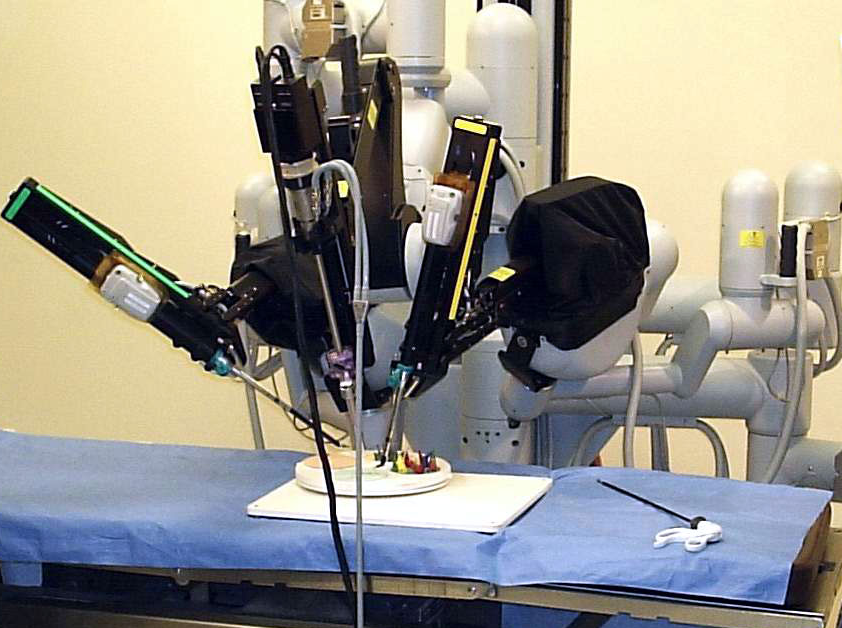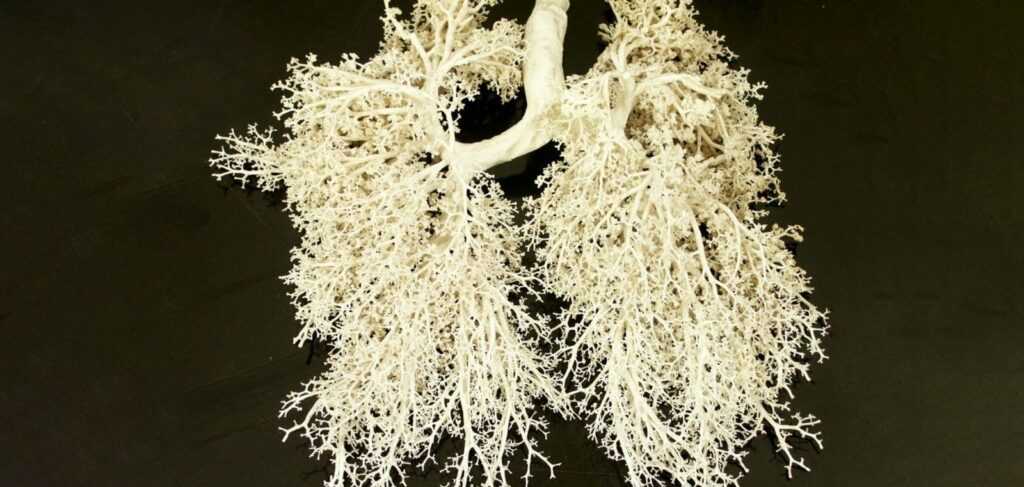
Robot and human: six-handed surgery
We enter the operating room and find the surgeon… not near the patient at all, but a little to the side. He is looking at something through his 3D glasses and keeps moving his fingers. It’s like he’s playing some kind of online game.
– In fact, that’s exactly how the operation works,” Yevgeny Antonyuk, director of the Innomed Medical Center, hurriedly explains what I saw. – The doctor-surgeon sits at the remote control, his fingers lie on super-sensitive sensors. He sees the operated area in a three-dimensional projection, has the opportunity to enlarge it and operates virtually remotely: the robot’s instrument is fully transmitted to the movements of the surgeon’s fingers. And he feels that he manipulates simply with his hands, without a tool.
Da Vinci robot
The machine at which the specialist is now working is called the surgeon’s console. It is a kind of control console – it is arranged so that operations can be performed across continents. In addition, the Da Vinci robotic surgeon has two more units: the patient console – this is directly “four-armed” robot, through which the intervention is carried out, and the instrument rack with equipment. In total, the Da Vinci robotic surgeon weighs one and a half tons. When the surgeon at the console controls the actions of the robot, they operate in six hands: four “hands” at the Da Vinci robot, two at the specialist. Why so many? In fact, not all the robotic arms are used at the same time, and their functionality is different.
– One of the robot’s arms is a camera that is inserted through an incision and broadcasts images of the operated area,” explains Evgeny Sergeevich, ”the other two arms repeat the movements of the surgeon-operator in real time, and the fourth arm acts as an assistant. As a rule, in gynecological interventions, two hands of the robot-surgeon are enough, in operations on the intestines or prostate, three hands are usually used. But there are large surgeries when a human and a robot are assisted by another surgeon.
It would seem that since laparoscopy began to be used in surgery, there are no unreachable areas for the instrument, and surgeons can work much more precisely thanks to the use of the camera. But in reality, the laparoscopic instrument in the surgical field can not perform all movements. In contrast, the Da Vinci robotic surgeon is designed so that the instruments rotate in the operating field without restrictions, that is, 360°. Their functionality allows them to perform movements of complex amplitude in all directions, which makes it possible to perform the operation more ergonomically, without making large-scale incisions.
At the fingertips
Visualization of the operating field on the Da Vinci robot deserves special attention. A special lens design shows the intervention site as if the surgeon were directly in the operating field. The high resolution of the camera provides maximum quality, and the possibility of multiple zooming allows you to work on the smallest anatomical structures. As surgeons like to joke, Da Vinci’s hands are not shaky, so the risk of complications is minimal.
– You can find publications on the Internet that the Da Vinci robotic surgeon damaged organs during surgery,” continues Evgeny Antonyuk. – In fact, this is not a robot error, but a careless movement of the surgeon-operator, because his movements are perceived by the system. Yes, the human factor cannot be turned off here. But the robot still minimizes the surgeon’s accidental movements. Let me explain with this example: each surgeon works in an individual rhythm, and the robot adapts to this. If during the operation some movement is erroneous or the pace or speed changes, the robot stops.
The scope of application of the Da Vinci robot is expanding
The Innomed Medical Center wanted to have a Da Vinci robot 10 years ago. But in May 2018, they came close to mastering this type of surgery. Innomed surgeons Andrei Grigorenko, Ruslan Tserkovniuk and Yuri Demidenko were trained in the official representative office of the manufacturer in Strasbourg and underwent training in clinics in the United States and Israel, where robot-assisted surgery is used.
– In fact, any surgeon can start working with the system,” says the clinic director. – On the unit, he should perform as many test operations as it takes to adjust his skills and thinking to robotic surgery. In parallel, training was conducted in Ukraine for Innomed’s junior medical staff, technicians and even nurses: everyone had to learn the intricacies of working with the robot-assisted system.
– A surgeon using Da Vinci device is able to perform all operations: from ordinary apendectomy to large-scale interventions for abdominal cavity pathologies, – continues Evgeniy Antonyuk. – But economically feasible are the so-called gold standard operations: removal of prostate tumors, malignant neoplasms of rectum and colon, gynecological interventions.
The use of Da Vinci in the treatment of prostate cancer has many advantages over conventional surgeries. This is due to significantly less blood loss and traumatization during surgery to remove the neoplasm, less painkillers in the rehabilitation period and faster recovery. Against the background of these successes, gynecologic oncologists have paid attention to the possibilities of robotic surgery. Today urology-oncourology, gynecology-oncogynecology and colorectal surgery are leading in the use of Da Vinci. The robotic surgeon is also involved in general surgery, otolaryngology, thoracic surgery and so on. In Los Angeles, the Johanson Cancer Center has developed a revolutionary method of surgical treatment of laryngeal, oral cavity cancer and other malignant tumors of the head and neck using Da Vinci. In many cases, these tumors are localized in hard-to-reach areas. And for this reason, as well as because of the closely located nerves and large blood vessels, doctors used to refuse to intervene quite often. And if they were performed, patients could eventually need plastic surgery to reconstruct facial tissues. Da Vinci in the hands-manipulators hold specially made miniature surgical instruments and can penetrate into hard-to-reach places through the mouth or nose, which eliminates the need for tissue cuts from the outside. This method is called TORS (trans oral robotic surgery).
Reduce the cost for the patient
If a clinic in a particular country has a Da Vinci, the client always has a choice whether he or she will be operated with or without the help of the robot. It all depends on the financial possibilities. Intervention with a robot usually costs 2-3 times more than a conventional one. For example, in Turkey it is reportedly 5 thousand dollars. Now Ukrainian surgeons are considering whether there is a possibility to reduce the price of surgery, at least to make it cheaper than in Europe.
– The fact that Da Vinci robot-surgeon appeared in Ukraine for the first time in a private clinic is an exception rather than a rule, – says Evgeniy Sergeevich. – The fact is that this robot-assisted system has been working successfully in many state clinics of the world for a long time. Now for domestic budgetary institutions to buy Da Vinci is almost unrealistic. Even for a private clinic it is a significant expense. The Innomed Medical Center was helped to buy Da Vinci by investors who believed in the professionalism of our doctors. But buying it is only half the battle. You need to make it work. A rather significant cost item associated with the work of Da Vinci is the instruments. One set is enough for about 10 operations. Then it needs to be replaced. The cost of one is 3 thousand dollars. This affects the cost of the operation. If the patient is not able to pay for it, the robot will just stand there. In countries where insurance medicine is developed, there is a demand for robot surgeries, because patients’ costs are covered by insurance payments. In our country, this is still impossible. It would be good if the medical reform would create conditions for the introduction of robotic surgery in Ukraine. Now we are seeing positive changes in the financing of primary health care system. If changes occur in the secondary level, it will be a huge impetus for the development of robotic surgery in Ukraine.



